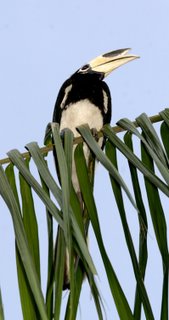Caterpillars and birds
Caterpillars are regularly eaten by birds. However, most birds avoid the noxious ones, especially those that are brightly coloured and hairy. Cuckoos (Cuculidae) specialise on caterpillars as these are their favourite food and they have no hesitation eating even the noxious ones. The arboreal species generally perch motionless on a branch looking for caterpillars. When a one is spotted, the bird grabs it and returns to its perch to eat it. Because caterpillar guts may be filled with indigestible and toxic leaf matters, the bird carefully removes the contents. This is done by biting off one end and gently thrash it against a branch. Once the gut contents are removed, the bird swallows it whole. Sometimes the caterpillar is passed back and forth through the bill to remove the contents. Hairy caterpillars are similarly swiped against a branch, not to remove the hairs, but to empty it of its gut contents. The birds apparently eat the caterpillars together with the hairs, the latter forming a mat in the stomach. These hairs are regularly regurgitated as pellets.
We give below two personal accounts of how two different species of local birds handle large caterpillars.

 Robert Teo reported seeing an Oriental Pied Hornbill (Anthracoceros albirostris) in Pulau Ubin that caught a caterpillar of the Atlas Moth (Attacus atlas). This moth is the largest in Southeast Asia and possibly in the world. It's bluish green caterpillar has a series of dorsal and sub-dorsal spines. The hornbill had the caterpillar in its beak and was vigorously shaking it before finally swallowing it.
Robert Teo reported seeing an Oriental Pied Hornbill (Anthracoceros albirostris) in Pulau Ubin that caught a caterpillar of the Atlas Moth (Attacus atlas). This moth is the largest in Southeast Asia and possibly in the world. It's bluish green caterpillar has a series of dorsal and sub-dorsal spines. The hornbill had the caterpillar in its beak and was vigorously shaking it before finally swallowing it.Tan Hang Chong tells of another incident: "As I was birding along Lorong Sesuai some years ago, I chanced upon a Crow-billed Drongo (Dicrurus annectans). The bird was perched on a tree at eye level and I had the opportunity to observe it for a long while. What caught my immediately attention was that it had one of the largest tan-coloured caterpillar I had ever seen in its beak! The caterpillar was easily 15 cm long and as thick as my finger.
"The drongo started to move the caterpillar along its beak (ala cartoon characters eating a cob of corn). I initially presumed that the drongo was trying to flatten the caterpillar, the better to swallow it later. Thereafter, the drongo turned the caterpillar around, held it on its end and proceeded to swallow it whole. It surely looked like a most uncomfortable feat as the drongo's torso was not much longer than the caterpillar!"
Contributed by Robert Teo and Tan Hang Chong, additional input by YC; image of Atlas moth caterpillar by Angie Ng and of hornbill by YC.
Labels: Feeding



0 Comments:
Post a Comment
<< Home